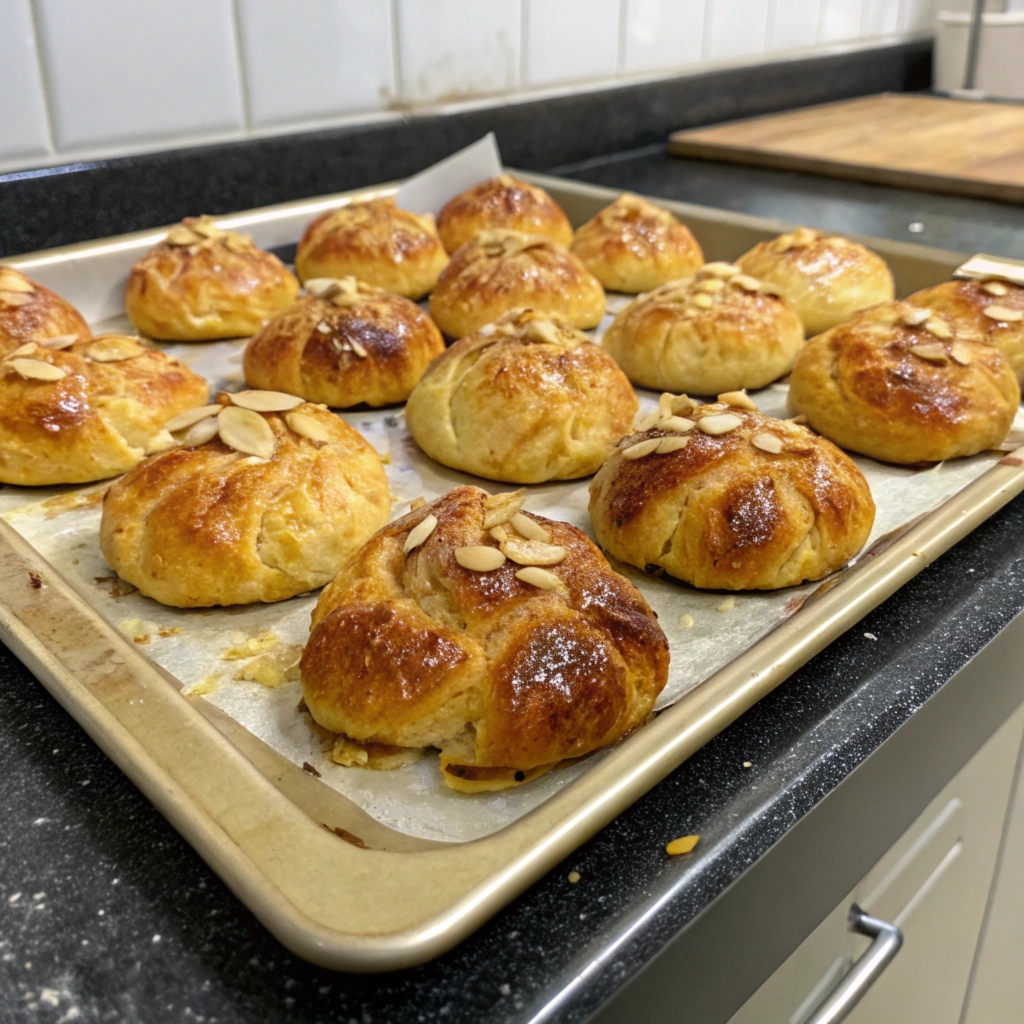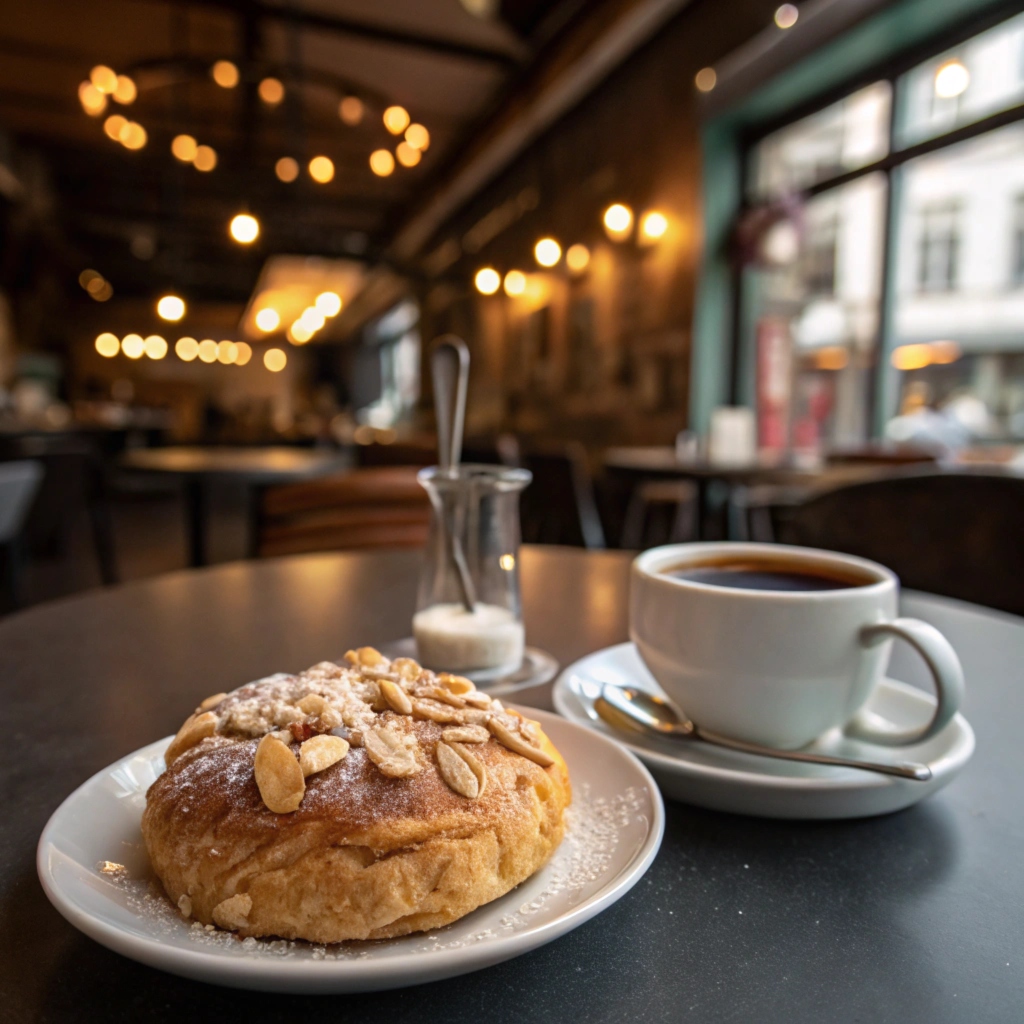Let’s start with the basics: what is a Mandelgipfel? Imagine biting into a warm, flaky, buttery pastry filled with a sweet almond mixture that melts in your mouth. Sounds divine, right? That’s exactly what this Swiss treasure is all about! The Mandelgipfel, directly translating to “almond crescent” in German, is a crescent-shaped pastry beloved in Switzerland and beyond.
While it may look similar to a croissant at first glance, a Mandelgipfel is in a league of its own. Its dough is slightly denser, offering a satisfying texture that complements the rich almond filling. Think of it as the croissant’s heartier, nuttier cousin. But let’s dive deeper because there’s so much more to this delicious treat than meets the eye.
Table of contents
The History of Mandelgipfel
Every pastry has a story, and the Mandelgipfel is no different. It carries with it a slice of European history that’s as rich as its filling.
Originating in Switzerland
The Mandelgipfel hails from Switzerland, a country famed for its meticulous craftsmanship—whether it’s watches, chocolate, or pastries. This iconic treat was born in the bakeries of Swiss-German regions, where the art of creating baked goods was a tradition passed down through generations.
The Swiss people take their pastries seriously, and the Mandelgipfel reflects this devotion. Early versions were likely inspired by Austrian and German baking techniques, but the Swiss added their own twist: the almond filling. Almonds, once considered a luxury ingredient, were a symbol of elegance and indulgence, making the Mandelgipfel a special occasion treat.
“The best things in life are often the simplest—flour, butter, almonds, and a little love. That’s the magic of a Mandelgipfel.”
Influence of European Pastry Culture
You might be wondering: how does the Mandelgipfel compare to other European pastries? Well, the almond filling connects it to French almond croissants, while its crescent shape nods to Austrian Kipferl (a precursor to the croissant). However, the Mandelgipfel’s heart and soul remain uniquely Swiss.
Over the years, Swiss bakers began experimenting with flavors and textures, making the Mandelgipfel a symbol of local pride. It’s the pastry equivalent of comfort food—perfect for a snowy Alpine morning or a cozy café break.
What Makes a Mandelgipfel Unique?
Key Ingredients: Almonds and Dough
At its core, the Mandelgipfel uses simple yet premium ingredients. The filling is a luscious mixture of ground almonds, sugar, and egg whites, often enhanced with a touch of vanilla or almond extract. This filling is wrapped in buttery dough, creating a contrast of textures—soft and creamy on the inside, flaky and golden on the outside.
But here’s the kicker: it’s not just about the ingredients. It’s the balance of flavors that makes a Mandelgipfel shine. The sweetness of the almond paste never overpowers the buttery, slightly savory dough. It’s like a well-composed symphony, where every element plays its part perfectly.
The Perfect Balance of Flavor
Ever heard of the “Goldilocks effect”? That’s what a good Mandelgipfel achieves. Not too sweet, not too heavy—just right. It’s a treat that doesn’t leave you feeling guilty but still satisfies your dessert cravings. And that’s not easy to pull off!
This balance is what makes the Mandelgipfel a favorite for all occasions, whether it’s breakfast, a midday snack, or even dessert after a hearty Swiss meal. Pair it with a strong cup of coffee, and you’re set for the day.
“A Mandelgipfel is more than just a pastry—it’s a moment of joy wrapped in golden layers.”
How Mandelgipfel Is Made
The secret to a great Mandelgipfel lies in the method. Baking one requires patience and precision, but the results are worth every minute.
Traditional Recipe Steps
Traditional Mandelgipfel starts with laminated dough, similar to croissant dough but slightly less flaky. The dough is rolled out, filled with almond paste, and carefully shaped into crescents. Each pastry is brushed with egg wash, sprinkled with slivered almonds, and baked until golden brown. Finally, a light dusting of powdered sugar adds that finishing touch.
We’ll dive deeper into the recipe in Part 3, but for now, imagine the aroma of freshly baked Mandelgipfel wafting through your kitchen. Heavenly, isn’t it?
Modern Variations and Twists
Like all beloved foods, the Mandelgipfel has evolved over time. Today, you’ll find versions filled with chocolate, hazelnuts, or even fruit preserves. Some bakers experiment with whole-grain or gluten-free dough, catering to modern dietary preferences.
But purists will argue: nothing beats the classic almond filling. And honestly? They’re not wrong. The traditional recipe is a masterpiece that needs no improvement.

The Experience of Eating Mandelgipfel
Let’s get personal—imagine holding a warm, freshly baked Mandelgipfel in your hand. The almond aroma draws you in before you even take a bite. The first crunch of the flaky outer layer gives way to a soft, nutty center that melts on your tongue. Eating a Mandelgipfel isn’t just a snack; it’s an experience.
Whether you’re enjoying it in a quaint Swiss café or in the comfort of your kitchen, the joy of a Mandelgipfel is universal. It’s a moment of indulgence, a treat that feels special yet familiar.
Ideal Pairings: Coffee or Tea?
What’s the best way to elevate your Mandelgipfel experience? Pair it with a drink that complements its rich flavors. Coffee, with its bold and slightly bitter profile, is a classic choice. The contrast of a strong espresso with the sweetness of the pastry creates a perfect harmony. ☕
Prefer tea? No problem! A light, floral tea like Earl Grey or chamomile pairs beautifully, enhancing the delicate almond notes without overpowering them.
The Joy of Freshly Baked Pastry
There’s something magical about eating a Mandelgipfel fresh out of the oven. The texture is just right—the exterior is crisp and golden, while the filling is warm and fragrant. If you’ve ever experienced the disappointment of a stale pastry, you’ll appreciate the importance of freshness even more.
For the ultimate experience, try making them at home. The aroma alone is worth the effort!
Common Problems and Solutions
Like any recipe, Mandelgipfel can be tricky to perfect. But don’t worry—we’ve got your back with solutions to the most common problems.
Troubleshooting Dough Texture
- Problem: The dough is too hard or dry.
- Solution: Make sure you’re using cold butter and don’t overwork the dough. Adding a splash of milk or water can help achieve the right consistency.
- Pro Tip: Resting the dough for the recommended time ensures it’s pliable and easy to work with.
- Problem: The dough doesn’t rise properly.
- Solution: This might be due to inactive yeast or a cold environment. Use fresh yeast and allow the dough to rise in a warm spot.
Avoiding Overly Sweet Fillings
- Problem: The almond filling turns out cloyingly sweet.
- Solution: Balance is key. Use unsweetened ground almonds and adjust the sugar to taste. A hint of salt can also enhance the overall flavor.
“Think of the filling as the heart of your Mandelgipfel. Too much sugar can overpower its nutty goodness.”
- Problem: The filling leaks out during baking.
- Solution: Seal the edges of the dough properly and avoid overfilling. Chilling the shaped pastries before baking can also help keep the filling intact.
Why Mandelgipfel Deserves More Love
It’s surprising that Mandelgipfel isn’t as famous as croissants or Danish pastries. But maybe that’s part of its charm—it’s a hidden gem waiting to be discovered by more people.
A Hidden Gem Among Pastries
While croissants often steal the spotlight, the Mandelgipfel quietly wins hearts with its understated elegance. It’s the pastry you didn’t know you needed, offering a unique combination of flavors and textures that’s hard to beat.
If you’ve ever felt like croissants are “too plain” or Danishes are “too sweet,” a Mandelgipfel is your Goldilocks pastry: just right.
Where to Find the Best Mandelgipfel
- In Switzerland: Local bakeries are the best places to try an authentic Mandelgipfel. Zürich, Bern, and Lucerne have countless options where you’ll find this pastry freshly baked every morning.
- Outside Switzerland: While Mandelgipfel isn’t as widely available as croissants, some specialty European bakeries carry them. You can also try your hand at making them at home!
“Mandelgipfel might not be the most famous pastry, but it’s definitely the one you’ll remember after the first bite.”
How to Make Mandelgipfel at Home
If you’re ready to bring the magic of Mandelgipfel into your own kitchen, this is the part you’ve been waiting for! Making them might seem intimidating at first, but with a little patience and the right guidance, you’ll be crafting bakery-quality pastries in no time.
Step-by-Step Instructions
Here’s a foolproof recipe to create your own Mandelgipfel at home.
Ingredients:
For the Dough:
- 250g (2 cups) all-purpose flour
- 150g (2/3 cup) cold unsalted butter (cut into small cubes)
- 1 tbsp granulated sugar
- 1/4 tsp salt
- 8 tbsp cold water
For the Almond Filling:
- 150g (1 1/2 cups) ground almonds
- 100g (1/2 cup) granulated sugar
- 1 egg white
- 1/2 tsp almond extract (optional)
Topping:
- 1 egg yolk (for brushing)
- 2 tbsp slivered almonds
- Powdered sugar (for dusting)
Directions:
- Prepare the Dough:
- In a large mixing bowl, combine flour, sugar, and salt. Add the cold butter and rub it into the flour using your fingertips until it resembles coarse breadcrumbs.
- Gradually add the cold water, one tablespoon at a time, and mix until the dough comes together. Avoid overmixing.
- Wrap the dough in plastic wrap and refrigerate for at least 30 minutes.
- Make the Almond Filling:
- Mix ground almonds, sugar, egg white, and almond extract in a bowl until a thick paste forms. Set aside.
- Roll and Shape the Dough:
- On a floured surface, roll out the chilled dough into a rectangle (about 3mm thick). Cut it into 8-10 triangles.
- Place a small spoonful of almond filling at the wide end of each triangle. Gently roll the dough towards the tip to form a crescent shape.
- Brush and Add Toppings:
- Place the shaped Mandelgipfel on a parchment-lined baking sheet. Brush with egg yolk and sprinkle with slivered almonds.
- Refrigerate the shaped pastries for 10-15 minutes to prevent spreading during baking.
- Bake:
- Preheat your oven to 180°C (350°F).
- Bake the Mandelgipfel for 20-25 minutes or until golden brown.
- Finish with a Dusting:
- Let the pastries cool slightly, then dust with powdered sugar for that perfect finishing touch.
Tips for Beginners
- Use Cold Ingredients: Cold butter and water are essential for achieving the flaky texture in the dough.
- Don’t Overfill: A little almond filling goes a long way. Too much can cause the filling to leak during baking.
- Chill Before Baking: This step helps the dough maintain its shape and prevents spreading in the oven.
Modern Twists on the Recipe
Feeling adventurous? Here are some creative variations to try:
- Chocolate Mandelgipfel: Add a dollop of chocolate hazelnut spread along with the almond filling.
- Fruit-Infused Mandelgipfel: Mix a bit of fruit preserve (like raspberry or apricot) into the almond filling.
- Vegan Mandelgipfel: Use vegan butter and replace the egg white in the filling with a flaxseed or aquafaba substitute.
“Baking is like creating art—don’t be afraid to experiment and make it your own.”

Frequently Asked Questions (FAQ)
How Long Do Mandelgipfel Stay Fresh?
Mandelgipfel are best enjoyed fresh, but they can be stored in an airtight container at room temperature for up to 2 days. To extend their life, you can refrigerate them for up to a week or freeze them for up to a month. Simply reheat in the oven to regain their crispness.
Can They Be Frozen?
Absolutely! Mandelgipfel freeze beautifully. After baking, let them cool completely, then wrap individually in plastic wrap and store in a freezer-safe bag. Reheat directly from frozen at 180°C (350°F) for 10 minutes.
More Ideas
If the Mandelgipfel has piqued your interest, why not explore other delightful recipes, baking tips, and culinary pairings? Here are some exciting ideas and related resources to expand your pastry journey!
Dive Into Swiss Pastries and Baking
- How to Make the Perfect Gipfeli Recipe – Ideas, Pairings, and Tips
Discover the art of making Gipfeli, another iconic Swiss pastry. Learn how it differs from Mandelgipfel and get tips for perfecting your technique.
Read more: How to Make the Perfect Gipfeli Recipe - Difference Between Croissant and Gipfeli
Ever wondered how Gipfeli compares to the classic croissant? This guide explains the differences and similarities, helping you appreciate both!
Read more: Difference Between Croissant and Gipfeli
Mastering Almond-Based Treats
- Almond Nut Cake Recipe
Love almonds? This moist almond nut cake is a perfect complement to your Mandelgipfel experiments.
Read more: Almond Nut Cake Recipe - Baking with Almond Flour
Interested in almond flour? Learn how to incorporate it into your baking for a healthier twist without compromising on flavor.
Read more: Baking with Almond Flour - Difference Between Marzipan and Almond Paste
Curious about the filling in Mandelgipfel? Understand the nuances between marzipan and almond paste and how they’re used in baking.
Read more: Difference Between Marzipan and Almond Paste
Pastry Pairing and Dessert Ideas
- What Flavor Goes Well with Almond Cake?
Learn how to pair flavors with almond-based desserts like Mandelgipfel for a perfect menu.
Read more: What Flavor Goes Well with Almond Cake? - Secret to Super Moist Cake
Want to elevate your pastry game? Explore tips to make your baked goods irresistibly moist and flavorful.
Read more: Secret to Super Moist Cake
Expand Your Culinary Repertoire
- Easy Pastalaya Recipe
Step away from pastries and explore this hearty and unique dish for your next savory craving.
Read more: Easy Pastalaya Recipe - Difference Between Crème Brûlée and Custard
Looking for another dessert adventure? Learn about the key differences between these two creamy classics.
Read more: Difference Between Crème Brûlée and Custard - What Is Crème Brûlée Mostly Made Of?
A deep dive into the ingredients and preparation of this rich and elegant dessert.
Read more: What Is Crème Brûlée Mostly Made Of?
Conclusion
The Mandelgipfel is more than just a pastry—it’s a little piece of Swiss culture wrapped in flaky layers and filled with nutty sweetness. Whether you’re discovering it for the first time or reliving fond memories of a Swiss café, this crescent-shaped delight never fails to impress. From its humble origins to its modern variations, the Mandelgipfel embodies the perfect balance of tradition and taste.
Now that you know its history, how to make it, and even a few creative twists, you’re ready to dive into the world of baking this iconic treat. Whether you stick to the classic recipe or put your own spin on it, the Mandelgipfel is guaranteed to bring joy to your kitchen and smiles to those who taste it.
So why wait? Roll up your sleeves, gather your ingredients, and let the delicious aroma of freshly baked Mandelgipfel fill your home. As the Swiss say, “En Guete!” (Enjoy your meal!)
Let me know if you’d like to add anything else!
